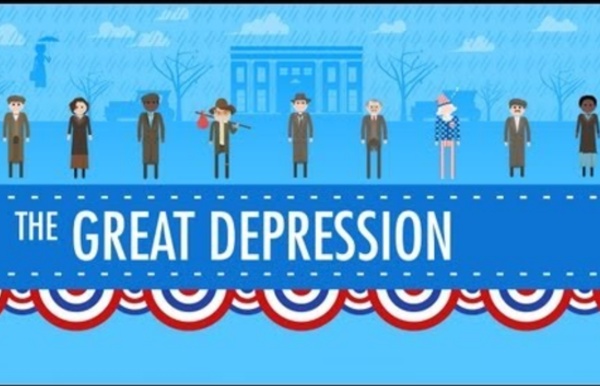



http://www.youtube.com/watch?v=GCQfMWAikyU
Great Depression - Facts & Summary Hoover, a Republican who had formerly served as U.S. secretary of commerce, believed that government should not directly intervene in the economy, and that it did not have the responsibility to create jobs or provide economic relief for its citizens. In 1932, however, with the country mired in the depths of the Great Depression and some 15 million people (more than 20 percent of the U.S. population at the time) unemployed, Democrat Franklin D. Roosevelt won an overwhelming victory in the presidential election. By Inauguration Day (March 4, 1933), every U.S. state had ordered all remaining banks to close at the end of the fourth wave of banking panics, and the U.S. Treasury didn’t have enough cash to pay all government workers. Nonetheless, FDR (as he was known) projected a calm energy and optimism, famously declaring that “the only thing we have to fear is fear itself.”
The Great Depression During the economic boom of the Roaring Twenties, the traditional values of rural America were challenged by the Jazz Age, symbolized by women smoking, drinking, and wearing short skirts. The average American was busy buying automobiles and household appliances, and speculating in the stock market, where big money could be made. Those appliances were bought on credit, however. Although businesses had made huge gains — 65 percent — from the mechanization of manufacturing, the average worker’s wages had only increased 8 percent. The imbalance between the rich and the poor, with 0.1 percent of society earning the same total income as 42 percent, combined with production of more and more goods and rising personal debt, could not be sustained. On Black Tuesday, October 29, 1929, the stock market crashed, triggering the Great Depression, the worst economic collapse in the history of the modern industrial world.
Great Depression Timeline: 1929 - 1941 June 17: Hoover signed the Smoot-Hawley Tariff Act, which raised taxes on 900 imports. It originally was supposed to help farmers but ended up imposing tariffs on hundreds of other products. Other countries retaliated, setting off a trade war. As a result, international trade began to collapse. A drought hit 23 states from the Mississippi River to the mid-Atlantic region. It was the first of what was later called the Dust Bowl drought, the worst in 300 years.
Life for the Average Family During the Great Depression The Great Depression, the worst economic downturn in modern history, profoundly affected the daily life of American families in ways large and small. The Great Depression (1929-1939) was the worst economic downturn in modern history. The preceding decade, known as the “Roaring Twenties,” was a time of relative affluence for many middle- and working-class families. As the economy boomed, new innovations allowed for more leisure time and the creation of a consumer society. But the economic depression that followed those boon years profoundly affected the daily life of American families, in ways large and small. Even the affluent faced severe belt-tightening.Four years after 1929 stock market crash, during the bleakest point of the Great Depression, about a quarter of the U.S. workforce was unemployed.
In this short video, author John Green gives a brief overview of the causes of the Great Depression. He speaks quickly so you may need to watch more than once! by ked10340 Sep 5